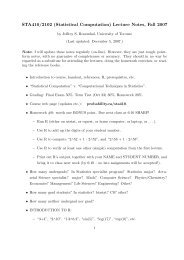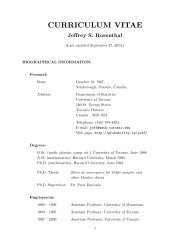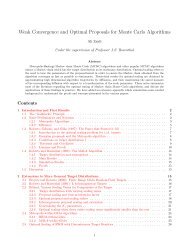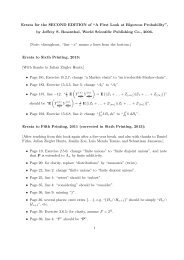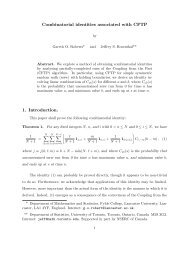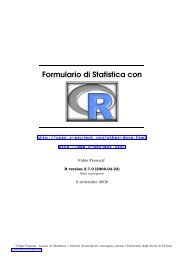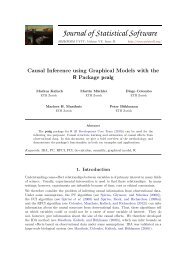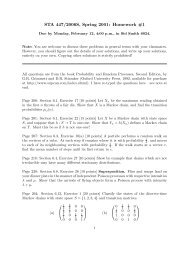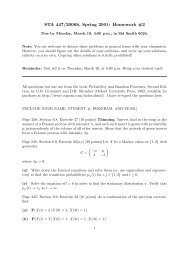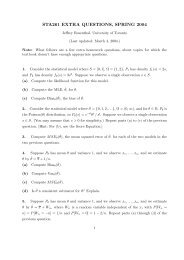Homework #2 - probability.ca
Homework #2 - probability.ca
Homework #2 - probability.ca
You also want an ePaper? Increase the reach of your titles
YUMPU automatically turns print PDFs into web optimized ePapers that Google loves.
4. Consider the undirected graph on the vertices V = {1, 2, 3, 4, 5}, with weights<br />
given by w(1, 2) = w(2, 1) = w(2, 3) = w(3, 2) = w(1, 3) = w(3, 1) = w(3, 4) = w(4, 3) =<br />
w(3, 5) = w(5, 3) = 1, and w(u, v) = 0 otherwise.<br />
(a) [3] Draw a picture of this graph.<br />
(b) [10] Compute (with full explanation) lim n→∞ P[X n = 3], where {X n } is the<br />
usual (simple) random walk on this graph.<br />
5. [10] Let {X n } be simple random walk on S = Z, with parameter p = 2/3, and with<br />
X 0 = 5. For any i ∈ Z, let T i = inf{n ≥ 1 : X n = i}. Compute (with full explanation)<br />
P 5 (T 0 < ∞). [Hint: First, use the Gambler’s Ruin formula to compute P 5 (T c < T 0 ), and<br />
hence P 5 (T 0 < T c ), for any c > 6. Then, consider (with justifi<strong>ca</strong>tion) the limit as c → ∞.]<br />
6. [A special <strong>ca</strong>se of the Gibbs Sampler.] Let S = Z × Z, and let f : S → (0, ∞) be<br />
some function from S to the positive real numbers. Let K = ∑ (x,y)∈S<br />
f(x, y), and assume<br />
that K < ∞. For x, y ∈ Z, let C(x) = ∑ w∈Z f(x, w), and R(y) = ∑ z∈Z<br />
f(z, y). Consider<br />
a Markov chain on S with transition probabilities given by<br />
(a) [5] Prove that<br />
p (x,y),(z,w) =<br />
∑<br />
(z,w)∈S<br />
⎧<br />
⎪⎨<br />
⎪⎩<br />
f(z, w) f(z, w)<br />
+<br />
2 C(x) 2 R(y) , x = z and y = w<br />
f(z, w)<br />
2 C(x) , x = z and y ≠ w<br />
f(z, w)<br />
2 R(y) , x ≠ z and y = w<br />
0 , otherwise<br />
p (x,y),(z,w) = 1 for all (x, y) ∈ S.<br />
(b) [5] Show that the chain is reversible with respect to π (x,y) = f(x,y)<br />
K .<br />
(c) [10] Compute lim<br />
n→∞ p(n) (x,y),(z,w)<br />
for all x, y, z, w ∈ Z (<strong>ca</strong>refully justifying each step).<br />
7. Let {Z i } be an i.i.d. collection of random variables with P[Z i = −1] = 3/4 and<br />
P[Z i = C] = 1/4, for some C > 0. Let X 0 = 5, and X n = 5 + Z 1 + Z 2 + . . . + Z n for n ≥ 1.<br />
Finally, let T = inf{n ≥ 1 : X n = 0 or Z n > 0}.<br />
(a) [5] Find (with explanation) a value of C such that {X n } is a martingale.<br />
(b) [2] For this value of C, compute (with explanation) E(X 9 ).<br />
(c) [3] For this value of C, compute (with explanation) E(X T ). [Hint: is T bounded?]<br />
2



